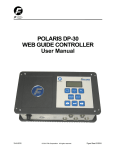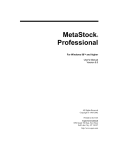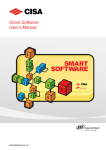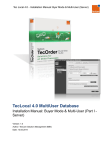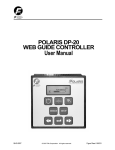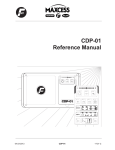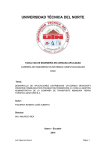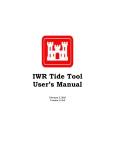Download Vision EndSight Manual
Transcript
Vision Metering EndSight™ User’s Manual ES-080312-REV2 Page 1 9/13/2012 Chapter: 1 ............................................................................................................................ 3 System Overview ............................................................................................................ 3 Data Streams ................................................................................................................... 4 System Configuration ..................................................................................................... 5 Chapter: 2 .......................................................................................................................... 12 Home Page .................................................................................................................... 12 Administration .............................................................................................................. 13 Host Information ........................................................................................................... 13 Radiogate ...................................................................................................................... 17 Radiogates Setup ........................................................................................................... 18 TCP Client Mode .......................................................................................................... 19 Meter Setup ................................................................................................................... 20 Customer Setup ............................................................................................................. 23 Modbus Protocol Tester ................................................................................................ 26 Radiogate Configuration ............................................................................................... 27 Updating Firmware ....................................................................................................... 29 Data Management ......................................................................................................... 31 View Collected Data ..................................................................................................... 33 Settings .......................................................................................................................... 35 Chapter: 3 .......................................................................................................................... 37 Sentry 950 ..................................................................................................................... 37 Chapter: 4 .......................................................................................................................... 38 Updating Software ........................................................................................................ 38 Page 2 9/13/2012 Chapter: 1 System Overview The EndSight™ software is used in conjunction with both Vision™ meters and the Radio Gate™ collectors which create the complete DataonDemand™ system. The meters are programmed to customer specifications. Several forms of data streams are available and selectable from EndSight™. The meter firmware has data stream embedded, therefore the meter must be ordered with a specific data stream. The meter sends this information to the collector which in turn delivers the data to the head end computer. This computer houses the software that allows a user to interpret the data, print reports and create a historical customer database. Page 3 9/13/2012 Data Streams As mentioned in the system overview, the data stream is the data that the meter sends to the radiogate. This data contains the information that the customer would like to retrieve from the meter. There are currently six segments of the data stream. The packet structure is found in the Host Information screen. Segments 3 and 4 may be chosen by the customer and the meters are programmed accordingly. The packet structure selections in EndSight must match the programmed meters in order to receive the proper data. The data stream is shown below along with the selectable segments for segments 3 and 4. More information on the packet structure screen can be found on page 15. 3 3 3 4 4 unsigned long SerNum; // 8 numerical symbols unsigned long TotA; // 4 bytes of Total phase A unsigned long TotB; // ...................... B unsigned long TotC; // ...................... C Rec_stream unsigned long Tot_rec_A; unsigned long Tot_rec_B; unsigned long Tot_rec_C; kW_stream unsigned long kW; unsigned long CUM_kW; unsigned long C_CUM_kW; mVA stream unsigned long mVA_A; unsigned long mVA_B; unsigned long mVA_C; Date_stream unsigned int Year_Month; unsigned int Date_Hour; unsigned int Min_Sec; Volt_stream unsigned int Volt_A; unsigned int Volt_B; unsigned int Volt_C; Current_stream unsigned int I_A; // ABC phases ***Currents unsigned int I_B; // ABC phases unsigned int I_C; // ABC phases unsigned int ph_A; // ... phase_A in 10ths,... unsigned int ph_B; // ... phase_B in 10ths,... unsigned int ph_C; // ... phase_C in 10ths,... unsigned int chksum; Page 4 Received Energy Stream kW Stream mVA Stream Date-Time Stream Volt Stream 9/13/2012 System Configuration It is recommended that this software be installed on a PC with at least a 64-bit operating system. It is also suggested to use Windows 7 and have a minimum of 2GB of RAM installed. This software is used in conjunction with Microsoft® SQL Server 2008 R2 Express with tools. Two SQL Server installation files have been provided. Ensure installation of the correct version depending on whether your system is 32bit or 64bit. For 32bit systems use the SQLEXPRWT_x86_ENU.exe file. For 64bit systems use the SQLEXPRWT_x64_ENU.exe file. Depending on the computer’s operating system it may be necessary to download other service packs in order for the server to be installed and run properly. Upon downloading the server follow all of the instructions and prompts provided by the installation guide. Once the server is installed on the computer, the next step is to connect to the server. To access the Microsoft Sever Management Studio left click the start button. Then left click on SQL Server 2008, and finally left click on Server Management Studio. This access can be simplified by creating a shortcut link on the desktop or pinning it to the taskbar. The link to the server is established with an INSTANCE ID. Simply use the same INSTANCE that was created during the installation process and left click the connect tab. This INSTANCE is input in the window pictured in figure 1. Figure 1 Page 5 9/13/2012 When the server connects properly the screen pictured below will appears which shows the name of the server and that it is connected. Disconnecting the server is also accomplished from this screen shown below in Figure 1B. Figure 1B Now that the server is installed and connected the next step is to connect the server to the database. The database (data and data log) files needed for this step are provided. Both of these files need to be saved on the hard drive in a new folder named radiogates as shown in figures 3 and 4. This can be accomplished by a left click on the start button, left click on computer, then a right click to open the hard drive, which is usually C. Once in the hard drive right click and choose new and then choose folder. It is imperative that the new folder just created is named radiogates (no caps). This is recognized and accessed by EndSight™ software so it must be accurate. Copy the data and data log files to the new radiogates folder. This folder will be attached to the server. REMAINDER OF THIS PAGE INTENTIONALY LEFT BLANK Page 6 9/13/2012 Figure 2 Figure 3 Page 7 9/13/2012 Next, open the Server Management Studio and verify that the server is still connected. If it is not, reconnect and right click on database and select attach. This is where to select the files located in the radiogates folder. This is shown in figure 5 and figure 6. Figure 4 Figure 5 Page 8 9/13/2012 Once the attach databases screen window is up, left click on the add button. This will show you the folders listed on the hard drive. Select the radiogates folder and then the data file. If the error message appears and will not attach then return to the radiogates folder and right click on each of the two folders and select properties. Left click on security and ensure that full control is checked. If not, then check full control and click apply. Now try to attach once again. Now that the server and database are installed and connected the only thing left to do is install the EndSight software and connect it to the database. Save the software and right click on the file and create a shortcut to the desktop. At this point everything needed is installed and accessible from the desktop. Open the EndSight program by left clicking on the shortcut icon and a window will open like the one pictured in figure 6. Figure 6 To connect the program to the database left click on the Administration button which opens a drop down menu that looks like the one pictured in figure 7. There are several options located in this menu; however the one needed at this point is Host Information. This window looks like the one pictured in figure 8. The three categories to choose from are General, Database, Packet Structure and Geo Service. At this Page 9 9/13/2012 point, select Database. Input the exact same INSTANCE ID that has been used thus far. Leave the attached database as radiogates and leave the authentication as windows. Do not change the username or password. Next, test the connection by clicking the test connection button which is located at bottom left of the screen. This is shown in Figure 8. Figure 7 Figure 8 Page 10 9/13/2012 If all is well, Connection OK will be displayed in a new window like the one in figure 9. If not, the error most likely lies in the INSTANCE ID. Simply verify that it is the same. Figure 9 Congratulations, the SQL server, database, and EndSight™ software have been successfully installed. The next chapter will cover all aspects of EndSight™ software and how to utilize them. REMAINDER OF THIS PAGE INTENTIONALY LEFT BLANK Page 11 9/13/2012 Chapter: 2 Home Page Now that everything is installed and running properly, it is time to become familiar with the EndSight software itself. Start by dissecting the home page. The picture below is the main page where navigation through EndSight™ begins. Figure 10 This is the home page shown in Figure 10. While in sub categories or different pages, returning to the home page can be done with a left click on Home. On this page the date and time are displayed in the lower left hand corner. In addition, notice the communication status which can be either OFF-LINE or READ DATA. Just below the communication status section are the Start and Stop buttons which begin or cease data collection respectively. To begin collection of data left click the Start button and to stop collection of data left click the Stop button. Along with the Home button; Administration, Data Management, Reports, Sentry 950 and Exit are located on the banner near the top of the page. Before continuing forward into each of these segments, notice the Exit button. A left click on this tab will close this program. Page 12 9/13/2012 Administration Clicking on Administration will offer numerous choices to select from as shown in figure 11. This is a menu for most of the initial setup functions for the radiogates and meters as well as the program itself. Figure 11 Host Information Recall, clicking on this tab opens the screen shown in figure 8 on page 11, where the connection to the database was made. Click on Host Information and open a window like the one pictured below in Figure 12. In this window there are four subsections; General, Database, Packet Structure and Geo Service. General provides three fields, two of which allow the user to input Owner Name and Owner Address. The other additional field is Mode. Mode offers the choice of File or Database. File is used for systems that do not use a database and server. The data is then available in the form of an Excel spreadsheet. Database is the default. By clicking on Database tab a window that looks like the one in Figure 13 opens. Because this step has already been completed while connecting to the database and it has been verified that the connection is good; leave all of the setting on this page alone for now. The Page 13 9/13/2012 Update Database button will update the database SQL file which eliminates multiple steps when updating Endight software. Figure 12 Figure 13 Page 14 9/13/2012 The Packet Structure tab allows modification of data stream delivered. However, the selections made in fields 3 and 4 must be how the meters are programmed. The packets can not contain every option at the same time but we do provide these options to the customer. This allows for a customized data stream ideal for individuals clients. Figure 13A shows the options for field 3. Figure 13B show the selectable options for field 4. Figure 13A Figure 13B Page 15 9/13/2012 Figure 14 shows the Geo Service screen. Here the user may enter the local address which simplifies the map search when locating a meter’s geographic location. Enter the address and click the Get Coordinates button then click Update. The HTML field is only used if the user chooses to use a server other than default. Figure 14 REMAINDER OF THIS PAGE INTENTIONALLY LEFT BLANK Page 16 9/13/2012 Radiogate This is a picture of the radiogate with the cover removed. In location 1 there are three LED’s. Green will be illuminated when power is supplied. Red will pulse and is the “heartbeat” of the radiogate. Yellow will be illuminated as data is being received. Location 2 is the jumper used when switching between dynamic and static IP addresses. Location 3 is the connection for the internet cable. This is only used on the primary radiogates sending the data to the head end computer. Location 4 is the power connection for 120/277. Location 5 is the mini USB connection which is used to program the radiogate with the computer. 1 2 3 4 5 Page 17 9/13/2012 Radiogates Setup Clicking on this link opens the page shown below in Figure 14. Here is where maintaining control of the radiogates in the field is accomplished. This is used for the radiogates that have direct access to the internet. Other radiogates in the field share information, collect data, and retransmit data to the primary radiogates with internet connections which send the information to the head end computer. This window provides access to add, remove or edit radiogates. When adding a radiogate to the system click the Add button and a window that looks like the one in Figure 15 opens. There are several fields to input. Radiogate Name can be any characters. Simply use the IP address or the physical address. Type should typically remain modbus master. The IP and Port is the actual IP address of the radiogate. Period is the time frame of reporting data from the radiogate to head end computer. The time is assigned in seconds. For example, if the request was to have the data transmitted every five minutes the entry in this field would be 300. The user may also edit an existing radiogate by clicking Edit. To remove a radiogate from the system click on the chosen radiogate and simply click Remove. Figure 14 Page 18 9/13/2012 Figure 15 TCP Client Mode This mode allows the head end computer to standby for transmitted data from the radiogate. The user can switch from modbus master to TCP client mode in the radiogates setup menu under the general tab. This gives the user the opportunity to change the IP address information remotely. The screen shot below shows where the mode change is made. Figure TCP1 Page 19 9/13/2012 Once the mode has been changed to TCP client the user can enter the desired IP addresses in the same window under the TCP Connection Settings tab. Here the Connect to address is the IP address of the radiogate. This must be entered to communicate with the radiogate. To change the IP address of the computer it must be entered in the Write Data field. Once these fields are filled the Read Settings and the Write Settings buttons become available. The Read Settings button allows the user to see the current radiogate settings remotely. The Write Data button allows the user to change the current settings. The screen shown below is the TCP Connection Settings screen and shows the discussed fields. Figure TCP2 Meter Setup Selecting Meter Setup from the Administration drop down menu will open a window that looks like the one in Figure 16. Editing the information associated with the meters in the field can be done from this location. Although the meters are individually entered into the system under the Data Management drop down menu in Import Meters Into the Database, customizing meter information is done here. The Serial Number field will already be filled in after importing the meters, however from here you can add Comm ID, Account ID and Customer Name. This customization can be extremely helpful with regard to record keeping and reports. This information may be edited by clicking on the Edit button which will provide the screen shown in figure 16-1. From here the user can edit address, geographic location, account number or user defined field data. Page 20 9/13/2012 Figure 16 Figure 16-1 Page 21 9/13/2012 While in the Edit Meter screen the user may enter the address for the meter location. Once the fields are filled in, click on the Get Coordinates button. Now that the latitude and longitude fields have populated, click the Select Location on the Map button. The screen below in Figure 16-2 will allow the user to mark the exact location of the desired meter. The user may select Map or Satellite and mark the exact location before clicking the save button. Figure 16-2 Figure 16-3 Page 22 9/13/2012 After meter locations have been saved in this fashion. The user will have the ability to find a meter location from the View Collected Data screen. Simply double click on any given meter row and the location will appear in a new window. This is shown in Figure 16-3. Customer Setup In addition to customizing meter information, EndSight™ also provides a location to personalize customer data. Figure 17 shows the Customer Setup screen. From here it is possible to customize individual customer information. Here the user can add, edit or remove customer information. For example, clicking the add button opens the screen shown in Figure 17-1. In this screen, there are fields to input customer name, address and phone number. If the user chooses to edit an existing entry, click the edit button and the screen in Figure 17-2 opens. This screen looks very similar to the add screen however, notice the assign meter tab located at the top of the screen. By clicking this tab, the screen shown in Figure 17-3 opens. Lastly, the user can edit the meter information associated with the customer by clicking the edit button. This action opens the window shown in Figure 17D which allows the customization of meter, address, user defined fields and even geographic location. Figure 17 Page 23 9/13/2012 Figure 17-1 Figure 17-2 Page 24 9/13/2012 Figure 17-3 Figure 17-4 Page 25 9/13/2012 Modbus Protocol Tester This selection allows testing the communication of a specific meter and it also provides the latest data. When clicking on Modbus Protocol Tester, a window will appear as shown in Figure 18. From this point, select the radiogates IP address and then click the Read Data button. Once the data is retrieved, selection of any meter serial number being transmitted from that IP address is accessible. An example of this is shown in Figure 19. Figure 18 REMAINDER OF THIS PAGE INTENTIONALLY LEFT BLANK Page 26 9/13/2012 Figure 19 Radiogate Configuration Before placing the radiogate in the field, it must be connected to the computer via mini USB and programmed properly. Start by determining the function of the radiogate. Functioning as a repeater or a primary unit connected to the internet changes this process slightly. Start by plugging the USB cable into the port labeled 5 on page 17. Under the administration tab click Radiogate Config and the screen pictured in Figure 19-1 will be visible. The COM Port will automatically be selected and shown in that field. Click the connect button to communicate directly to the radiogate. Page 27 9/13/2012 Figure 19-1 The screen shown in Radiogate 1 is broken down into the following fields: MAC: Is the assigned number to the board and firmware in each radiogate. This can not be changed. J3: Is associated with the jumper which was pictured and labeled as 2 on page 17. This is used to change the IP address setting from Static to Dynamic. When the jumper is in place the setting is Dynamic and when it is not the setting is Static. If the radiogate is connected to the computer when the jumper is applied or removed press the enter key to refresh the setting. The Dynamic setting allows the router to assign the IP address. When using the Static IP setting the IP address must be entered manually. To change the following fields enter the information below and press the enter key: IP: Enter the IP address only if J3 is off (Static IP is in use) and click send. MASK: Enter Mask address only if J3 is off (Static IP is in use) and click send. GATE: Enter Gateway only if J3 is off (Static IP is in use) and click send. HOST: This is the address of the head end computer. To change the address, enter the IP address and click send. PORT: This is part of the IP address and can be changed by entering the correct port and clicking send. Page 28 9/13/2012 TIME: This is the time frame of how often the radiogate transmits the data to the head end computer. The time can be changed by entering the desired time (in seconds) and clicking send. SCDA: When using modbus master with Endsight the SCDA port must match. If it needs to be changed enter the proper number and click send. REPEATER: This signifies whether the radiogate is a repeater or not. To designate the radiogate as a repeater enter 10 and click send. The numbers between 1 and 10 relate to signal strength. It is suggested to set signal strength at 10. If the radiogate is not going to be a repeater the enter 0 and click send. BootLoad: This is used to update the firmware of the radio gate. The radiogate firmware can be updated by clicking the Bootload button. This prepares the radiogate for programming which can be done with a flash programmer. This will be discussed thoroughly on page 20. The screen can be refreshed by clicking the refresh button. To exit the screen pictured in radiogate1 click the close button. Updating Firmware In order to program the radiogate with updated firmware, the use of the LM flash programmer is required which has been provided. Start by connecting the radiogate to the computer via mini USB cable as discussed in the radiogate configuration section on page 17. This cable provides power to the radiogate so external power source is necessary. Open the radiogate configuration screen and connect to the radiogate. Click the bootload button and the message “Bootload Command Was Sent” will be displayed. Also, on the radiogate configuration screen under the MAC address, “Ready for Programming” is visible. This is shown below in Figure 15A. Close the radiogate configuration screen and open the LM flash programmer. The main screen is the one pictured below in Com/flash1. Under configuration, make sure that the fields are filled out or selected as shown. Quickset is set to manual, interface is set to serial with baud rate set to 115200 and transfer size is 60. The COM port may be different as it is selected for you automatically unless it has been saved to reuse. Select the program tab which opens the screen shown in Com/flash2. Ensure that the reset MCU box is checked and the field for the program address offset is 1000. After selecting the firmware file with the browse button, click the program tab in the lower left corner and the process is started. The progress of programming is displayed by percentage and when the programming is complete, it is stated at the very bottom left hand corner of the window (Programming Complete). Page 29 9/13/2012 Figure 15A Com/flash 1 Page 30 9/13/2012 Com/flash 2 Data Management This is the second drop down menu on the home page. This menu provides access to Import Meters into Database, View Collected Data, Meter Search and Settings as shown in Figure 20. Figure 20 Page 31 9/13/2012 Import Meters Into the Database As mentioned under Meter Setup, when adding meters to the system, meters are entered in the window pictured below in Figure 21. Here adding, editing or removal can be done similarly to the Radiogates Setup. When adding a meter click the Add button and a new window will open requesting the communication ID and serial number like the one in Figure 22. Once both fields are filled in, click OK. After entering the desired meters click the Import button. This finalizes the addition by importing the recent entries into the database. Now, these meters are accessible under Meter Setup and Customer Setup where the data can be customized. From this location the user may also edit or remove meters. Figure 21 Page 32 9/13/2012 Figure22 View Collected Data This is located under Data Management and is used to view the data transmitted from the radiogates to the head end computer. The screen is pictured in Figure 23. From this location meter information on usage and connectivity can be viewed. The columns can be widened or narrowed by clicking and dragging the column boarders. Click and drag the entire column to move it to a more desirable location with respect to what is seen and in which order. Finding a particular meter’s geographic location is done easily by double clicking on that meter here. Including or excluding certain data from this screen can be controlled from the Settings menu. Page 33 9/13/2012 Figure 23 Meter Search The meter search function is useful for locating the information on a specific meter. In this window pictured in Figure 24, searching for a meter by Account ID, Address, Last Name or the two User Defined Fields is possible. Simply choose your method of search, fill in the field and click the Search button. An example is shown in Figure 24-1. Figure 24 Page 34 9/13/2012 Figure 24-1 Settings Lastly under the Data Management menu, the Settings tab opens the screen in Figure 25. Under User Defined Fields, the user can customize two user defined fields. In Figure 26 the Data Columns Visible tab opens the selectable information the user wishes to see in viewing collected data. Figure 27 shows the Meter Search Columns Visible which allows the user to select which information is viewed from searching. Figure 25 Page 35 9/13/2012 Figure 26 Figure 27 Page 36 9/13/2012 Chapter: 3 Sentry 950 This section of Endsight allows the incorporation of the Vision Sentry 950 handheld reader. Click on the Sentry 950 tab located on the Home page. This screen is shown below in Figure 28-1. Connect the handheld to the computer using the USB cable, select upload flash on the handheld and then select the appropriate COM Port. By clicking the Obtain Data button the screen will retrieve the data from the handheld and display it on this screen. At this point you may select which radiogate the meters would have been read by and click the save button at the bottom right corner of the screen. This action saves the downloaded data to the database. Figure 28-1 Page 37 9/13/2012 Chapter: 4 Updating Software When updating EndSight, it is necessary to change the desktop folder containing the execution files and data/data log files. The contents of the folder located on the desktop looks like the one pictured below in figure29. Figure 29 Start by selecting the folder on the desktop and delete it. Next, copy the new folder and paste it to the desktop. Now that the new folder is in place, open the SQL Sever Management Studio and connect it in the same fashion as described in the initial setup section of this text. Double click databases and right click radiogates. This will allow the selection of tasks and then select detach. This set of windows resembles the ones pictured in Figure 30. A new window will open so that the database to be detached can be checked. Select radiogates and then click ok. After the process is complete minimize the studio window and return to the folder previously copied to the desktop. Select both the data and data log files and save them in the radiogates folder on the hard drive in exactly the same manner as the initial setup section. Now that the updated files are once again located in the radiogates folder, the database can now be reattached to the server. Open the studio windows once again, right click databases and select attach. After the new window opens, click add. This is shown in Figure 31. Select the radiogates folder and double click the data file. Click the ok button and wait for the process to complete. The EndSight program can now be opened and run for normal operation. Do not forget to check the connection and fill out the fields in the Page 38 9/13/2012 Administration/Host Information menu. Refer to back to the Host Information section on page 14. Verify that the radio gates are listed in the Administration/Radiogate Setup menu. Refer back to the radiogate setup section on page 20. Figure 30 Figure 31 Page 39 9/13/2012








































